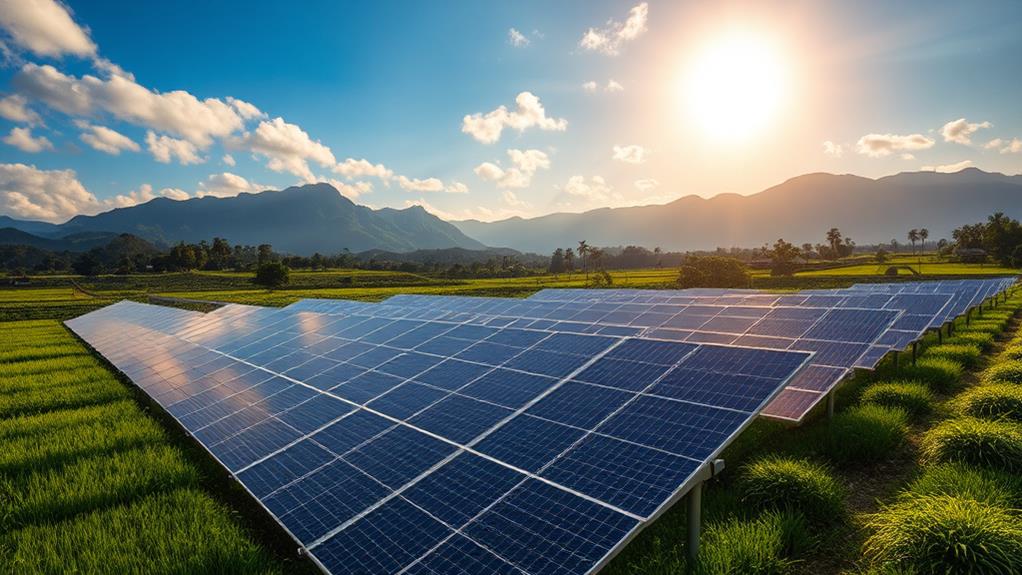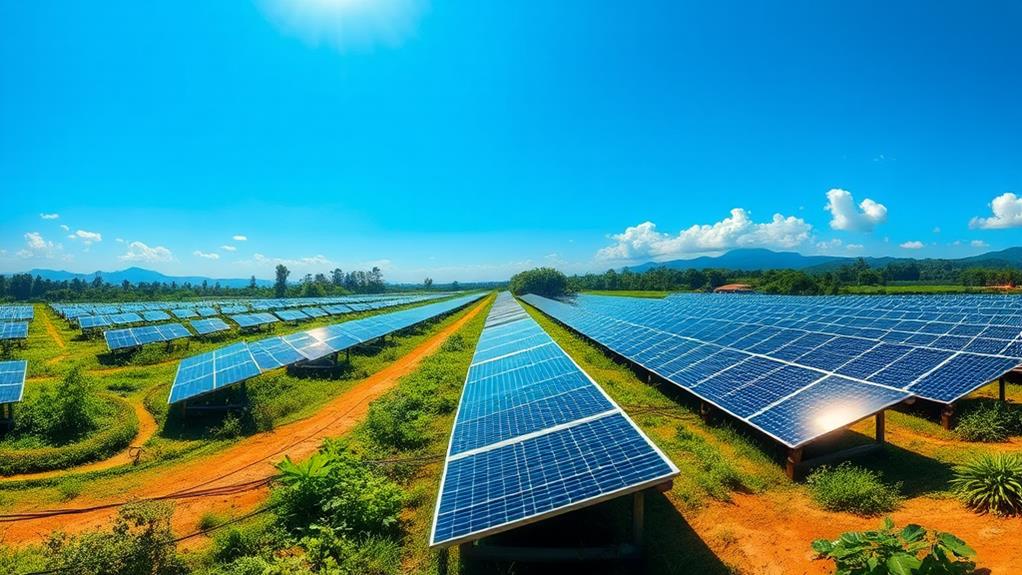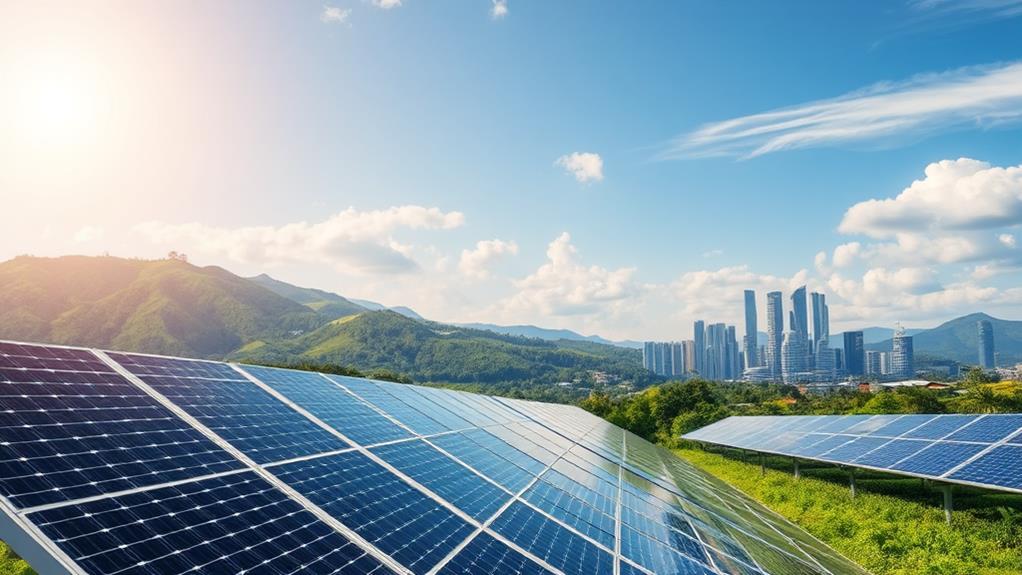The solar energy industry in the Philippines is expected to grow rapidly, with a projected annual growth rate of 25.20% from 2024 to 2029.
By the end of 2023, the installed capacity is forecasted to reach 1,700 MW. The goal is to exceed 5,229 MW within five years.
The country has a lot of sunlight, and advancements in technology have lowered solar energy costs.
Government support, including incentives, helps this growth. Ongoing projects and active companies in the market also contribute to the industry's potential.
Overview of Solar Energy

In the Philippines, solar energy is a crucial resource because the country receives a lot of sunlight. It has the potential to produce 5,000 MW of electricity, with daily solar radiation ranging from 5-6 kWh per square meter. This makes the Philippines very suitable for solar energy.
The solar market is growing quickly, with a projected annual growth rate of 25.20% from 2024 to 2029. By the end of 2023, it's expected that installations will reach 1,700 MW, and they could exceed 5,229.62 MW in the next five years.
The main technologies used for solar energy include photovoltaic (PV) systems for homes and businesses, and concentrated solar power (CSP) systems for large energy production.
Adopting solar energy helps the environment by reducing greenhouse gas emissions. It also boosts the economy by creating jobs in areas like manufacturing, installation, and maintenance. This shows how important solar energy is for the Philippines.
Benefits of Solar Energy
Solar energy provides both environmental and economic benefits for the Philippines. Solar power reduces carbon emissions, which helps create a cleaner environment and lessens the country's reliance on fossil fuels. This is vital in the fight against climate change.
Additionally, the cost of producing rooftop solar energy is between PhP2.50 to PhP5.30 (USD0.05 to USD0.10) per kWh, making it more affordable than electricity generated from coal.
The solar industry also boosts the economy by creating jobs in areas like manufacturing, installation, and maintenance. Businesses in the commercial and industrial sectors can expect an internal rate of return of 14-16% from solar investments.
Furthermore, using more solar energy means greater energy independence for the Philippines, which reduces the need for imported fossil fuels. This strengthens national energy security and lessens the effects of price changes in the fossil fuel market.
Public support for solar energy is strong, with 85% of Filipinos in favor of adopting solar power. This widespread approval helps build a solid foundation for renewable energy projects, leading to a more sustainable future.
Current Market Trends

The solar energy market in the Philippines is growing quickly. From 2024 to 2029, it's expected to grow at a rate of 25.20% each year. By the end of 2023, there will be about 1,700 MW of solar PV installations, and the goal is to reach 5,229.62 MW by 2029.
Here are some important trends:
- Costs are decreasing. Solar technology has become 75% cheaper over the last seven years.
- Renewable energy goals. The Philippine Energy Plan aims for 35% of energy to come from renewable sources by 2030.
- Installation growth. Solar PV installations were 1,625 MW in 2022, showing steady progress.
- New projects. There are ongoing floating solar initiatives, including a 3.5 GW solar farm extension.
Additionally, government incentives support an annual growth rate of 20% in the solar energy market. This indicates a bright future for solar energy in the Philippines.
Government Support and Incentives
The Philippines recognizes the importance of solar energy and supports its growth through government actions. The Renewable Energy Act of 2008 was created to help develop solar energy and aims to double renewable energy capacity by 2030. This law encourages solar projects and helps investors get funding through the Philippine REIT Law.
To attract both local and foreign investors, the government offers incentives such as tax breaks, feed-in tariffs, and net metering. These incentives create a favorable financial environment for solar technology.
The National Renewable Energy Plan targets an installed solar capacity of 1,528 MW, showing the government's commitment to this energy source.
Local government units also help by enforcing environmental regulations. This teamwork between national policies and local governments speeds up the adoption of solar energy.
Key Market Players

The solar energy sector in the Philippines is growing due to strong government support. Key market players are working to shape this industry.
There are several companies making important contributions to solar projects. Here are four major players:
- Solar Philippines Power Project Holdings is a leader in solar installations, known for projects like a 3.5GW solar farm in Luzon.
- Solenergy Systems Inc. provides end-to-end solar solutions for both homes and businesses, making solar energy more accessible.
- Vena Energy invests heavily in renewable projects and is dedicated to sustainable energy development and innovation.
- Solaric Corp. and Trina Solar Ltd. work together on technology advancements to improve solar energy efficiency.
These companies are increasing their market share and helping to make solar energy solutions more efficient and sustainable in the Philippines.
Their efforts are crucial for the future of renewable energy.
Challenges Facing the Industry
The solar energy industry in the Philippines faces several big challenges that could slow its growth. High installation costs for solar panels are a major problem. Many low-income families can't afford these upfront costs, which prevents them from using solar energy.
Regulatory hurdles also create issues. Complex approval processes and poor policies can cause delays in starting solar projects. For example, getting the necessary permits can take a long time, which frustrates developers.
Another challenge is the limited grid infrastructure. In many areas, the existing power systems can't easily integrate solar energy. This makes it hard for solar energy to be reliable and stable. For instance, if the grid can't handle the extra energy, solar power may not be used effectively.
Competition from fossil fuels is another significant challenge. Traditional energy sources often receive government subsidies, making them cheaper than solar energy. This financial advantage makes it harder for solar power to compete in the market.
Lastly, weather variability affects solar energy production. Inconsistent weather can lead to lower energy generation, making it difficult for solar energy to be dependable.
These challenges create a tough environment for those involved in the solar energy sector. To succeed, it's important to find solutions to these problems and help solar energy reach its full potential.
How is the Growth and Potential of the Solar Energy Industry Contributing to the Renewable Energy Development in the Philippines?
The growth and potential of the solar energy industry are significantly contributing to renewable energy development in the Philippines. As the demand for clean and sustainable energy sources increases, the focus on harnessing solar power is playing a crucial role in the country’s efforts to promote renewable energy development philippines.
Future Growth Projections

The Philippine solar energy market is set to grow significantly. It's expected to increase at a 25.20% annual growth rate from 2024 to 2029. This growth is mainly due to government support and new technologies that make solar energy more efficient.
By the end of 2023, 1,700 Megawatts of solar capacity will be installed, and this number is projected to rise to 5,229.62 Megawatts in five years.
Several key factors will drive this growth:
- There's a rising need for renewable energy sources.
- The costs of solar technology are decreasing, making it more affordable for people to use.
- The Philippine Energy Plan aims for 35% of the energy mix to come from renewable sources by 2030.
- The government and private sectors are working together to improve electricity access in rural areas.
These factors will lead to significant revenue growth in the solar energy market, making it an essential part of the country's energy strategy.
As more solar PV systems are installed, the way energy is generated will change, leading to a sustainable and resilient energy future for the Philippines.
Environmental Impact of Solar Energy
The growth of solar energy in the Philippines has important environmental benefits.
Solar energy helps reduce greenhouse gas emissions. This is vital for fighting climate change because it lessens our dependence on fossil fuels, which are major sources of carbon dioxide and pollution. Using solar power not only leads to cleaner air but also improves public health and lowers healthcare costs related to pollution.
Solar energy systems use much less water than traditional energy sources. This helps conserve water and reduces the environmental harm caused by energy methods that need a lot of water. With careful planning, solar projects can also support local wildlife.
Solar farms usually disturb less land than fossil fuel extraction. They can even work alongside farming through dual-use systems, where land is used for both solar energy and agriculture.
Solar technologies promote sustainable development. They provide clean energy access while supporting economic growth and protecting the environment. By choosing solar energy, you're playing a significant role in creating a healthier planet and a sustainable future.
Questions and Answers
What Is the Potential for Solar Energy in the Philippines?
The potential for solar energy in the Philippines is very high. The country receives a lot of sunlight throughout the year, making it ideal for solar power. Investment opportunities are growing, as both local and foreign companies are looking to invest in solar projects. For example, several solar farms have been built in provinces like Tarlac and Cebu.
Economic benefits include job creation in the renewable energy sector. As more solar projects develop, people will find work in installation and maintenance. Additionally, solar energy can lower electricity costs for families and businesses in the long run.
Environmental improvements are significant as solar energy reduces reliance on fossil fuels. This leads to less air pollution and a smaller carbon footprint. An example is the use of solar panels in rural areas, which helps provide electricity to communities that previously had none.
Government incentives support solar energy growth. Policies and programs encourage individuals and businesses to invest in solar technology. For instance, tax breaks and grants are available for those who install solar panels.
What Is the Status of Solar Power in the Philippines?
Solar power in the Philippines is growing rapidly. This growth is due to government incentives that encourage the use of solar energy. For example, local companies are installing more solar panels in homes and businesses. Additionally, energy storage systems are becoming more common, allowing people to store solar energy for later use.
Local manufacturing of solar equipment is also increasing. This means that more products are made within the country, which helps the economy. Community projects are being developed to provide solar power to areas without electricity. These projects increase public awareness about the benefits of solar energy.
What Is the Future Growth of the Solar Industry?
The solar industry will grow due to advancements in technology, government support, and investment opportunities. For example, new solar panels are more efficient and cheaper to produce, making them accessible to more people. Government incentives like tax credits help homeowners and businesses install solar systems. Investment opportunities in solar projects attract more funding, which boosts the industry.
Public awareness about the benefits of solar energy is increasing. Many communities are starting solar initiatives, such as shared solar farms, which allow multiple people to benefit from one solar installation. Furthermore, international collaborations between countries work to improve solar technology and increase energy independence.
However, the industry faces challenges like grid integration and market competition. Integrating solar energy into existing power grids can be complicated, but advancements are being made. Additionally, more companies entering the market create competition, which can drive prices down but may also challenge existing businesses.
What Is the Potential of Renewable Energy Resources in the Philippines?
The Philippines has a large potential for renewable energy. This includes wind energy, which can be harnessed in areas like Ilocos Norte, where strong winds are common. There are also hydropower projects, such as the Maria Cristina Hydroelectric Plant, which generates electricity from flowing water. The country is rich in geothermal resources, especially in areas like Leyte, where heat from the Earth is used to produce energy. Additionally, there is biomass potential, which uses organic materials like rice husks and coconut waste for energy. The government supports these efforts through energy policies and incentives to encourage investment and promote rural electrification.